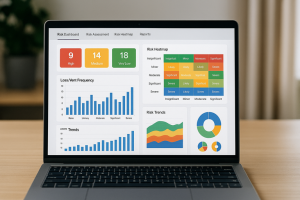Transforming Internal Risk Reporting through Innovation
Challenge

Our client, a major operator in the transport and logistics sector, works within high-risk, highly regulated environments where safety, environmental performance, and operational continuity are critical. Their existing risk reporting processes were fragmented and heavily reliant on static documents, making it difficult for executives and operational leaders to access meaningful insights in real time.
Risk reporting was rudimentary, it was not very user friendly, making it difficult to interpret and understand. The risk reports did not tell a story or highlight where the actual high risks in the business actually were, what was the trend and identify specific areas where things are most likely to go wrong. This was both from an occupational health and safety, as well as from a strategic and commercial risk perspective.
Risk was a reactive process, that was required to be performed for regular management and board meetings, as opposed to a proactive process. Documents were not reviewed regularly, there was poor version control and manual document systems rendered some of the documents being redundant. These documentation issues could lead to mis-representation or mis interpretation and understanding of risk throughout the organisation.
Real time risk insights were not being gained, as risk management was not a continuous process, it was a piecemeal effort, and a response to reporting. The indicators of risk and performance used, were also lagging indicators, as opposed to leading indicators.
For example, lagging indicators were used (ie the number of recordable injuries or lost time incidents (lagging indicator of safety performance).
Leading indicators were not being used, ones which proactively measure and provide early warning signs of potential risk events. These indicators help organisations take preventative action before an incident occurs. Some examples of leading indicators:
- Increase in staff fatigue levels or overtime hours (leading indicator for workplace accidents).
- The number of overdue maintenance checks on critical equipment (leading indicator for mechanical failure).
- Decline in employee engagement survey scores (leading indicator for staff turnover or culture-related risks).
The organisation required a more dynamic, transparent, and actionable way to report and manage risk internally.
E-Risk360’s Approach
E-Risk360 partnered with the client to reimagine how risk data was collected, analysed, and communicated across the business. We implemented a suite of innovative, interactive risk dashboards designed to integrate live data from audits, incidents, and compliance activities.
These interactive dashboards visualised risk on a sliding scale from high risk, medium risk to low risk, and used a colour coding system to represent or profile the organisational risks. Whereby high risk (red), medium (orange) and low risk (green), these colour coding represented risk, similar to a traffic light system. The interactive dashboard visualised risk across the organisation, enabling users to quickly and easily view priority risk areas and quickly identify trends, areas to focus on. Again it was easy to understand, interpret and review risk across the organisation, staff were empowered and bought into the risk profiles/dashboards. These interactive dashboards were adopted across all the business units and were rolled out successfully.
Designed in alignment with ISO 31000 and ISO 45001 standards, the dashboards were customised to suit the client’s operational complexity and stakeholder needs.
Impact
The introduction of E-Risk360’s risk dashboards marked a significant cultural and operational shift. For the first time, the executive team had access to a clear, consolidated view of organisational risk, enabling faster, more focused and informed decision-making. Operational teams became more engaged with risk ownership, supported by intuitive visual tools that made complex data easy to interpret. This led to improved audit readiness, quicker issue resolution, and a measurable reduction in risk exposure. Most importantly, our client is now empowered with a forward-looking, strategic view of risk, turning compliance into a competitive growth advantage.